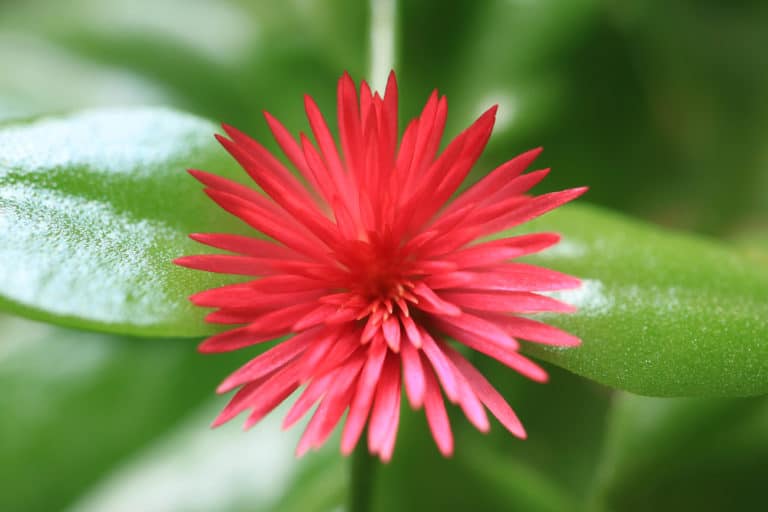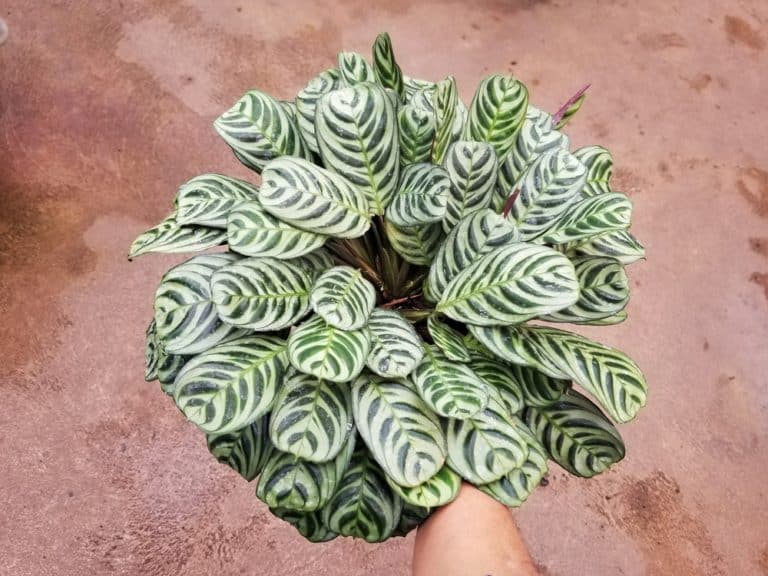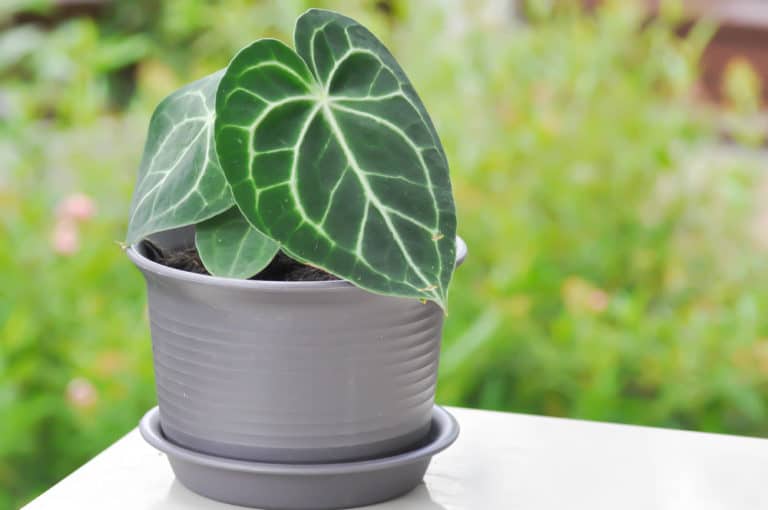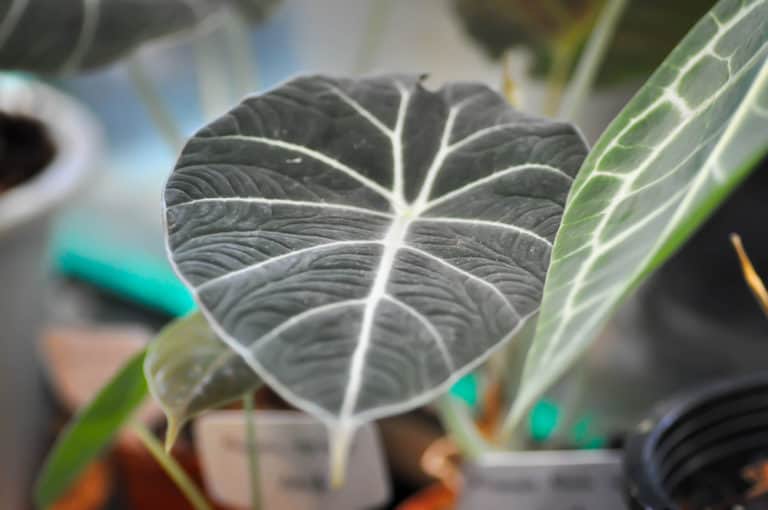Dracaena Fragrans ‘Janet Craig’ Care Guide (2024)
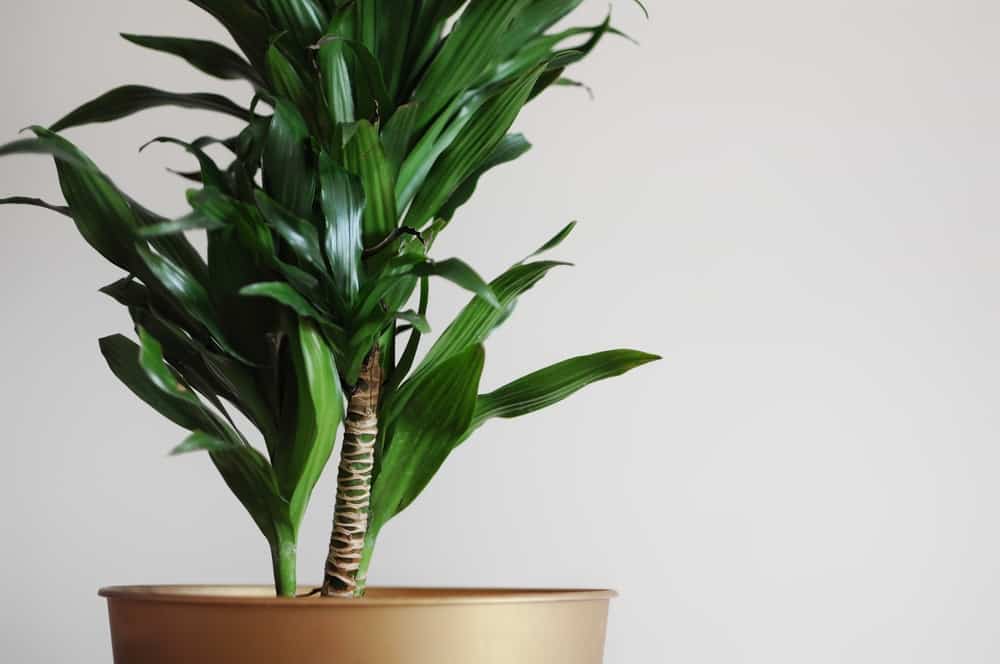
Dracaena fragrans “Janet Craig” is one of the most dependable houseplants around.
Its evergreen, glossy leaves and tall growing habit combine to make the Janet Craig plant a perfect fix for an empty corner.
If you live in a climate that stays warm year-round, it’s also a great landscaping plant.
| Scientific Name | Dracaena fragrans ‘Janet Craig’ |
| Common Name | Janet Craig, Dracaena Janet Craig, corn plant |
| Light | Bright indirect sunlight |
| Watering | Water if the top half of the soil is dry |
| Temperature | 65 to 90ºF (18 to 32ºC) |
| Hardiness Zone | 10 to 12 |
| Humidity | 40 to 80% |
| Soil Type | Loose, quick-draining |
| Soil pH | 6.1 to 6.5 (mildly acidic) |
| Fertilizing | A balanced feed once every 3 months in spring and summer |
| Repotting | Every 2 to 3 years |
| Pruning | Beginning of the growing season |
| Propagation | Root in soil |
| Toxicity | Toxic to humans and pets |
| Mature Size | 4 to 6 feet as a houseplant |
| Bloom Time | Rarely blooms indoors |
What’s Unique About Janet Craig Plant?
The Janet Craig plant’s ancestors are native to a broad swath of tropical Africa, from Ethiopia to Zimbabwe and Mozambique to Guinea.
It’s a variant of Dracaena Warneckii that was discovered in the 1930s, and a Philadelphia nurseryman named it after his daughter.
Janet Craig plants are notable for their long, glossy leaves and strong, thick central stems that make them look like miniature trees.
Growing Janet Craig plant is really easy, as it is one of the toughest houseplants around and will survive in almost any indoor environment. It’s perfect for beginner growers.
The Janet Craig plant is also remarkable for its ability to filter all sorts of indoor air pollutants, so it’s not just decorative but also useful!
Janet Craig Plant Care
In the tropical African rainforests where Dracaena Warneckii originates, the corn plant family is used to growing in hot, humid conditions under the shade of the tree canopy.
Luckily, Janet Craig plant care does not require you to turn your home into an equatorial jungle.
Rather, focus your Dracena Janet Craig care on warm temperatures and moderate humidity in a bright location.
Light
The Janet Craig plant light requirements are extremely flexible.
While the ideal Dracena Janet Craig light needs are for bright, indirect light, or between 10,000 and 20,000 lux, it will tolerate almost any light level short of full sun.
You can place it in a shady corner with only 250 to 500 lux, and it will stay healthy.
Make sure it gets at least 8 hours of natural or artificial light a day.
An east or north-facing window is an ideal spot for your Janet Craig plant, where it will get lots of indirect light.
If all you have is a south or west exposure, you have to find a spot for it where the direct sun will never touch it, as the foliage will be damaged.
Watering
While rainforests are, of course, fairly damp environments, they actually have fairly free-draining soil, so Janet Craig plant will not tolerate sitting in wet soil.
You should not have a schedule for Janet Craig plant watering, but rather a schedule for checking its soil moisture.
Water Dracena Janet Craig whenever the top half of the soil has dried out.
Janet Craig plant’s watering needs are best met with rainwater or distilled water, as the fluoride and chlorine in tap water can damage the plant.
If you have no other option, let the tap water sit in an open container overnight to let the chemicals dissipate.
Temperature
The corn plant is a tropical native, so of course, the best temperature for Dracena Janet Craig is hot.
The Janet Craig plant temperature range is from 65 to 90ºF (18 to 32ºC).
It does not have much temperature tolerance above that range. Leaves will get discolored and misshapen when it’s too hot.
The Janet Craig plant will be quite happy at normal room temperatures, but make sure that it is not exposed to drafts or too close to a cold window.
It does not have any cold hardiness; It will suffer at temperatures lower than 55ºF (12ºC), and frost will kill it.
Humidity
The ideal humidity for Dracena Janet Craig is as high as 80%. The corn plant, after all, evolved in the steamy rainforests of Africa.
However, the Janet Craig plant humidity requirements are remarkably flexible. It will be happy with a humidity level as low as 40%.
If you do see your Janet Craig plant’s leaves developing brown tips or margins, you will need to provide it with a more humid microclimate.
Misting only gives a temporary fix. You can set the Janet Craig plant’s pot on a pebble tray filled with water, or invest in a small humidifier for a more effective solution.
Soil
The rainforest home of the corn plant has a spongy texture with lots of organic matter, so you should aim for something similar for soil for Dracena Janet Craig.
Your Janet Craig plant soil has to be loose and well-draining, as this plant will not tolerate its roots sitting in soggy soil.
You should have a pH level for Dracena Janet Craig of 6.1 to 6.5, or mildly acidic.
While some growers recommend using perlite in a soil mix for Janet Craig plant, it’s not a good idea, as it can add fluoride to the soil.
Instead, a mix of equal parts potting soil, peat moss, and gravel or sand will be a good soil for your Janet Craig plant.
Fertilizer
While you should sometimes use a Janet Craig plant fertilizer, you do not want to overdo it.
It’s best to stick to 2 annual applications of fertilizer for Dracena Janet Craig, once at the beginning of spring and then again in early summer.
Use a liquid fertilizer with a fertilizer ratio of 10-10-10, and dilute it to half the recommended strength.
If the tips of your Janet Craig plant’s leaves turn brown, there’s a good chance you’ve used too much fertilizer, and the salts have built up in the soil.
Flush the soil by running a stream of water through it for about 10 minutes, and then let it drain thoroughly.
Potting & Repotting
You will probably need to do Janet Craig plant repotting every 2 or 3 years.
It’s time for repotting Dracena Janet Craig when you start to see roots growing out of the drainage holes, or curling around the pot’s sides.
When it comes to pot size, you should never move up more than 1 or 2 at most. Too much empty soil will stay too moist and can contribute to root rot.
An unglazed terra cotta pot is perfect for your Janet Craig plant, as it will help regulate the soil moisture levels. It must have drainage holes.
Always use fresh potting soil when repotting your Janet Craig plant.
Pruning
You can actually get quite drastic with your Janet Craig plant pruning.
Cutting Dracena Janet Craig can be done in early spring. If it is simply too bare and spindly for your tastes, just cut it off at whatever height you want it.
The bare stump will sprout new leaves shortly for a more full and compact look.
You should, of course, cut off any dead or damaged leaves whenever they occur during the year.
However, if the only damage to a Janet Craig plant leaf is a little browning at the tip or along the margin, just trim the discolored edges off carefully with sharp, sterilized scissors.
Propagation
Janet Craig plant propagation is very easily done by rooting stem cuttings.
In fact, if you’ve just pruned a length of stem off of your Janet Craig plant, that’s the ideal way to use it up. Spring is the best time for this.
To propagate Dracena Janet Craig, cut the stem into 5-inch lengths.
It’s best to cut the bottom on a slant and the top with a straight cut, so you will know which is the top and which is the bottom. That matters!
Leave the stems out overnight to let them dry out a bit. Then, stick them bottom-side down into moist soil.
That’s it. In about 3 weeks, you should see some new growth, and later in the summer, you can plant the cuttings in their own individual pots.
Common Problems of Janet Craig Plant
As with most houseplants, you shouldn’t have many Janet Craig plant problems if you’ve done your best to meet its growing requirements.
However, if you do have some problems with Dracena Janet Craig, you can usually deal with them without losing your plant.
The leaves are always going to be the first thing to show you there’s an issue that needs to be resolved.
Pests
You shouldn’t have trouble with too many Janet Craig plant pests if you do just a little bit of preventative maintenance.
If you wipe down the leaves of your Dracena Janet Craig once a month with an insecticidal soap or neem oil solution, you should be able to keep most bugs away.
Spider mites will leave little yellow bumps on the leaves, as well as their webs. Taking your Janet Craig plant to the sink or shower and giving the foliage a good rinsing should get rid of them.
Mealybugs will gather under the leaves, forming white, fluffy colonies. Wipe them off with a cotton ball soaked in rubbing alcohol.
Scale insects will look like flat brown bumps on the stems and leaves. Scrape them off gently.
Diseases
You don’t have to worry as much about Janet Craig plant diseases if you are diligent about correct watering practices.
Dracena Janet Craig can be susceptible to fungal and bacterial diseases when exposed to too wet conditions.
Root rot is always a possibility when you overwater your Janet Craig plant.
If the leaves start drooping and turning yellow, and the stem starts to soften, there’s a good chance the roots are starting to turn black.
Cut off all parts that show signs of the disease, and replant what’s left in fresh soil in a disinfected pot.
Leaf spot can be a fungal or bacterial disease caused by wet leaves. Cut off all infected foliage and improve air circulation around your Janet Craig plant.
Growing Problems
Other growing problems are simply the result of not giving your Janet Craig plant good enough growing conditions.
However, if you can improve those elements, you should be able to cure your sick plant.
Brown leaf tips can mean the soil is too dry, the light is too bright, or the humidity is too low.
Curling leaves usually indicate that your Janet Craig plant is being exposed to lower temperatures than it will tolerate.
Brown margins to the leaves are a sign of high levels of salts and chlorine, which can happen if you are using treated tap water.
Toxicity of Janet Craig Plant
Dracena Janet Craig is mildly toxic to humans and dogs but can have more extreme effects on cats.
Its toxicity is a consequence of the saponin found in all parts of the plant, including, of course, the foliage.
While small amounts of saponin are also present in foods we eat, such as spinach, large quantities can cause fairly serious reactions.
For Humans
While humans can safely eat small amounts of saponin in foods like quinoa and chickpeas, in large quantities, it can be dangerous.
Ingesting high levels of saponins can cause bloating, vomiting, and diarrhea and require immediate medical attention.
Luckily, even young children are unlikely to take more than a little nibble of a Janet Craig plant leaf, as it has an extremely bitter, unpleasant taste.
Still, it’s best to impress upon your children from the earliest age that this and all other houseplants are strictly off-limits.
Even adults need to be careful when handling Janet Craig plants, as you can develop a case of dermatitis if you get the sap on your skin. Rinse it well after any exposure.
For Pets
While plants containing saponin are a risk to all pets, cats are a special concern.
In general, you may observe that your cat or dog shows signs of vomiting, diarrhea, and excessive drooling after eating some Janet Craig plant foliage.
Your cat may also have dilated pupils.
Because cats are usually smaller than dogs, even a small amount of foliage could have serious consequences. The saponin can cause blood cells to rupture and in extreme cases, can be fatal.
If your pet has eaten any foliage and is showing any of these signs, take it to the veterinarian as soon as possible.
Janet Craig Plant Appearance
The Janet Craig plant appearance is familiar to all from its decades of use as an almost indestructible indoor plant.
You can also find a newer cultivar, Dracaena ‘Janet Craig’ Compacta, that only grows to 2 feet high if you don’t have the room for the original.
Don’t count on it flowering indoors, but if it does, the blooms are fragrant.
Foliage
The foliage of Janet Craig plant has led to it being given the colloquial name ‘corn plant’, as the leaves are very similar.
A Janet Craig plant leaf grows directly out of the central stem. Indoors, they can grow 1 to 2 feet long, in a thin sword shape about 3 inches across.
An outdoor plant can have leaves up to 3 feet in length. They are dark, glossy green.
As the leaves lengthen, they will naturally droop downwards.
Because the leaves are evergreen, they will remain on the plant for a long time. It’s important to wipe them down periodically to keep them from getting dusty.
Flowering
The Dracena Janet Craig flower is not often seen on plants grown indoors, but Janet Craig plant flowering does sometimes occur.
When it is blooming, you will see thick, foot-long stalks with very fragrant white flowers.
However, most indoor growers are not that happy about the flowers. They produce large quantities of a sticky nectar that is difficult to clean off of carpets and furniture.
As well, the flower production diverts the plant’s energy from the development of new leaves, which are the main appeal of the Janet Craig plant.
As a result, many growers simply cut off the flower stalks when they first emerge.
Size and Growth
The eventual size of Janet Craig plant depends on whether it’s grown indoors or outdoors and how much you prune it.
Left on its own, an indoor Janet Craig plant can end up 4 to 6 feet high, with a spread of 1 to 3 feet.
Outdoors, it can top out at 15 feet.
The Janet Craig plant has a slow growth rate, taking more than 10 years to reach its full height indoors.
Over time, the older, lower leaves will drop off, exposing the thick stem.
It is recommended to plant at least 3 stems in a pot and trim them at different heights to create a fuller look.
Janet Craig Plant Fragrance
When it blooms, the Janet Craig plant fragrance is extremely strong.
While most people describe the scent as sweet, like honey, others find it unpleasant.
Everyone agrees, however, that it is overwhelming, especially in an enclosed space like a small office or studio apartment.
This is especially a problem in public spaces where some people may have strong reactions to fragrances.
Because of this and the sticky nectar that drips off of them, most growers remove the flowers from indoor Janet Craig plants.
Outdoors, the scent would be much less overpowering.
Aside from the flowers, the foliage has no fragrance at all.
Suggested Uses for Janet Craig Plant
The Janet Craig plant removes 79% of benzene and more formaldehyde than any plant except the bamboo palm from the indoor air.
This makes it ideal for anywhere where you’d like a healthy environment, whether it’s your windowless office, or city apartment bedroom.
It’s also a great accent plant for a shady corner where most other plants would suffer in the low-light conditions.
Outside on a balcony or patio, a row of potted Janet Craig plants can create a living screen for added privacy in the summer months.
In tropical zones, you can plant them in the ground for long-lasting landscape features.
FAQ
What is Janet Craig plant?
The Janet Craig plant is a tropical plant originally from the rainforests of equatorial Africa. It is a long-living evergreen foliage plant often grown as a houseplant.
How to identify Janet Craig plant?
The Janet Craig plant has long, narrow leaves that are a deep, glossy green, growing from a thick central stem that in time resembles a small tree.
How to care for Janet Craig plant?
The Janet Craig plant can be grown in anything from shady conditions to bright, indirect light, with moderately moist soil and high heat and moderate humidity.
How to grow Janet Craig plant indoors?
The Janet Craig plant can be grown under natural or artificial lights in a warm, fairly humid environment with regular watering and infrequent feeding.
How to grow Janet Craig plant outdoors?
The Janet Craig plant can be grown outdoors year-round in zones 10 to 12, either as a container plant or in the ground. In temperate zones, pots can be moved out in summer.
How fast does Janet Craig plant grow?
The Janet Craig plant has a slow growth rate, taking more than 10 years to reach its full size when grown indoors as a potted plant.
How tall does Janet Craig plant grow?
The Janet Craig plant will reach a height of 4 to 6 feet when grown indoors and 15 feet when grown outdoors in a tropical zone.
How to make Janet Craig plant grow faster?
The Janet Craig plant will grow its fastest when kept in very warm conditions with humidity as high as 80%, in very bright light out of the full sun.
How to stake Janet Craig plant?
The Janet Craig plant will sometimes need staking with a bamboo pole if the clump of leaves at the top is too heavy for the stem to support.
How to pot Janet Craig plant?
The Janet Craig plant should be planted in loose, well-draining soil with organic matter, preferably in an unglazed terra cotta pot with good drainage holes.
How to revive Janet Craig plant?
The Janet Craig plant is very sensitive to fluoride, so if it is developing brown tips, flush the soil with distilled or rainwater to remove the fluoride that has built up.
Why is my Janet Craig plant dying?
If your Janet Craig plant has yellowing leaves and softening stems, as well as blackened roots, you have a case of root rot. Cut out all affected parts and replant.
Why is my Janet Craig plant drooping?
If the leaves of your Janet Craig plant are drooping, you could be watering it too much or too little. Check the soil moisture levels and proceed accordingly.
How cold can Janet Craig plant tolerate?
The Janet Craig plant will not grow properly at temperatures below 55ºF (12ºC) for any length of time, and it will be killed by freezing temperatures.
How to get rid of pests on Janet Craig plant?
Janet Craig plant pests such as mealybugs or scale can be controlled by wiping down the leaves once a month with an insecticidal soap or neem oil solution.
Is Janet Craig plant toxic to cats?
Yes, the Janet Craig plant is toxic to cats. If your cat starts vomiting, especially blood, or has diarrhea, take it to the veterinarian immediately.
Is Janet Craig plant toxic to dogs?
Yes, the Janet Craig plant is toxic to dogs. If your dog is vomiting or drooling excessively or has diarrhea, it needs medical attention at once.
Is Janet Craig plant toxic to children?
Yes, the Janet Craig plant is toxic to children, although they are unlikely to eat the bitter foliage. If they ingest some and have vomiting or diarrhea, take them to the emergency room.
Is Janet Craig plant toxic to humans?
Yes, the Janet Craig plant is toxic to humans, although the worst that can happen to most adults is a rash from the sap. Rinse any off your skin immediately.
Does Janet Craig plant have a scent?
The Janet Craig plant flowers have a sweet smell that can be overpowering for people in an enclosed space. The foliage, however, has no fragrance.

